Every time I write a blog, Yoast keeps suggesting “The focus keyword doesn’t appear in the first paragraph of the copy.” So, here it is – Restaurant SEO.
I hope you’re happy, Yoast. Now give me that green signal.
I think you all have already guessed by the headline what this blog is about.
If not, then drum rolls, please! It’s Restaurant SEO (I just fit in the keyword again, subtly).
So, in this blog, I am going to talk about this brilliant art of playing with keywords and content to make you visible on the internet.
And the interesting part is, I am going to tell you how you can do SEO for your restaurant website.
Let’s get to it.
Table of Content
- What is SEO?
- Do Restaurants Really Need to Invest Time and Efforts in SEO?
- Here are Some of the Effective Restaurant SEO Tips
- On-Page SEO
- Get a website
- Define your target audience
- Keyword research
- Work on meta title, meta description, and URL
- Optimize content on the website
- Improve your website load time
- Make your website mobile-friendly
- Work on image SEO
- Use Google Search Console
- Off-Page SEO
- FAQs
What is SEO for Restaurants?
It is basically a process of optimizing a restaurant’s website or webpage to rank higher on search engines like Google, Bing, and Yahoo. Because, the higher the ranking, the better the chance of grabbing the attention of your potential/existing customers.
Types of SEO
Try to Google ‘what are the types of SEO’ and you will see different sources with different answers. And this might highly confuse you.
For your restaurant SEO strategy, you just need to focus on these two types of SEO:
- On-page SEO: This type of SEO is all about the actions you can take within your website to improve the search rankings.
- Off-page SEO: On the other hand, off-page is about performing actions outside your own website.
You’ll learn more about both of them going forward.
But, is the hype real?
Lately, SEO has become a buzzword. This abbreviation has literally created a whole industry around it, triggering both excitement and fear into marketers.
However, the real question here is — “Does SEO deliver good results?”
Millions and millions of people are constantly conducting searches (which is one of the primary sources of traffic) and often, it’s with commercial intent. If your company is not popping up in its search results, then you are likely to miss out on many opportunities.
Not to mention, SEO also provides quality traffic.
But again, the magic never happens in a snap. It takes time to get the desired results. You have to constantly work on your content to drive better results.
To help you understand better, here’s a video on how SEO works.
Now that you know what exactly SEO for restaurants is, its types, and whether it delivers results, let me address the main concern.
Should You Really Invest Time and Efforts in Your Restaurant Search Engine Optimization?
The answer to this is an absolute YES.
There was a time when going online was optional. But things have changed in this “Google It” era. Customers need to find you quickly and easily, across multiple platforms.
Furthermore, ‘word of mouth’ is currently happening online. People are now sharing their experiences on social media or review sites, instead of sharing them personally with their friends and family.
Take it as your job to influence the way people are talking about your brand.
Invest a good amount of time in digital marketing (especially restaurant website SEO). And I bet you’ll see wonders happening.
Word to the wise: Your restaurant website plays a vital role in your restaurant’s success. So, make sure you invest in a website.

Here are Some of the Effective Restaurant SEO Tips
In this section, I am going to cover all the necessary steps on how to do SEO for restaurants. I have already mentioned the types of SEO, so, here I am going to divide it into two sections.
On-Page SEO
#1 Get a website
The first and foremost SEO tip for restaurants is always “build a website”. A website is where all the magic happens!
Every restaurant must have a website (even if you’re not doing SEO). Because It is the first impression a potential guest has of your restaurant. It gives you a platform to tell your story, connect with guests, and give them an idea about who you are.
Further, an SEO-optimized website helps you rank higher in search results, attract more traffic, and convert that traffic into customers.
So, if you have a website, you can start optimizing it. But if you don’t, then you really need to get one created.
#2 Define your target audience
A target audience is a specific group of people who are likely to connect with your restaurant and dine. Also, they are the people who mostly have similar sort of characteristics and behaviours.
For example: If your restaurant also hosts open mic, then millennials and Gen Zs could be your target audience.
When you know, what sort of people you want to cater to, your marketing activities become much easier.
And this brings me to my next point.
#3 Keyword research
Now, the next thing you have to do is try and find the keywords your target audience is likely to search for.
For the example given above, the possible keywords could be an open mic, stand-up comedy, restaurant with live performances etc.
That’s not all. There could be more keywords available.
Here are some of the aspects you can consider when you’re researching keywords.
- Try and find keywords that relate to your products/services
- Brand messaging should also be a factor
- Perform competitor analysis and determine what keywords they are using
- Consider synonyms of your keywords
But, how to find the best keywords for restaurants?
There are certain tools available like Google Keyword Planner & Ubersuggest that will help you find all the relevant keywords.
Here’s how you can do it:
Google Keyword Planner
Step 1: Go to Google Keyword Planner and click ‘discover new keywords’
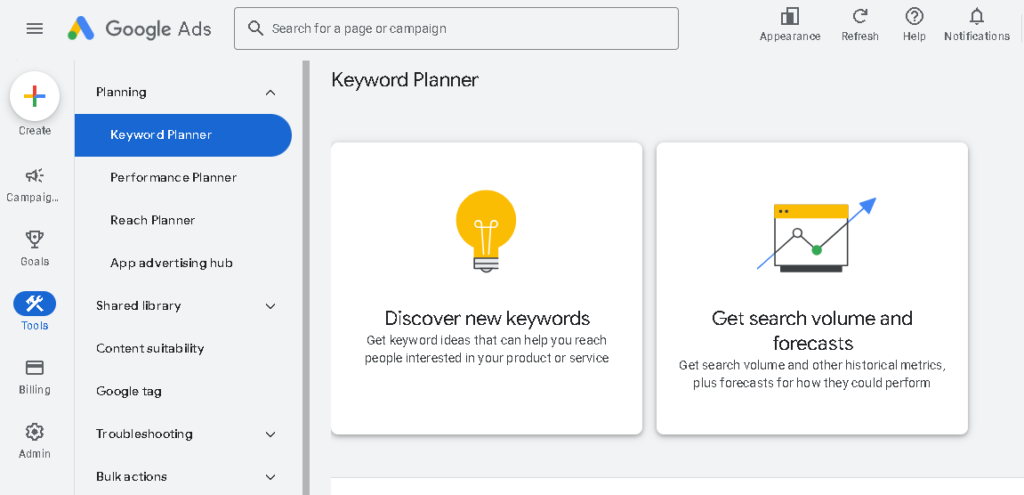
Step 2: Enter keywords (you can enter a maximum of 10 keywords) or an URL
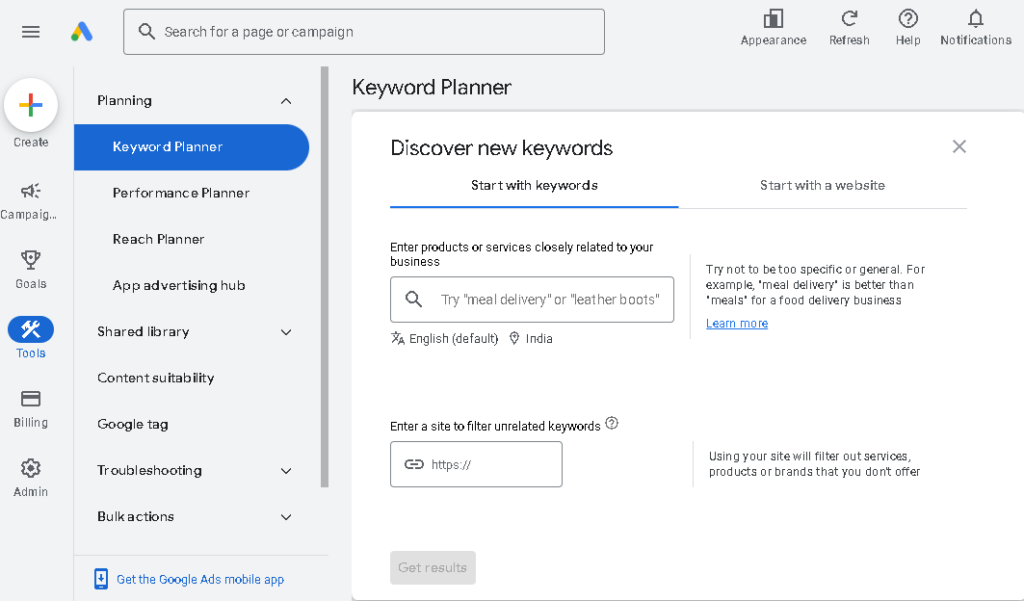
Step 3: Check all the keywords and decide on the ones that fit your restaurant
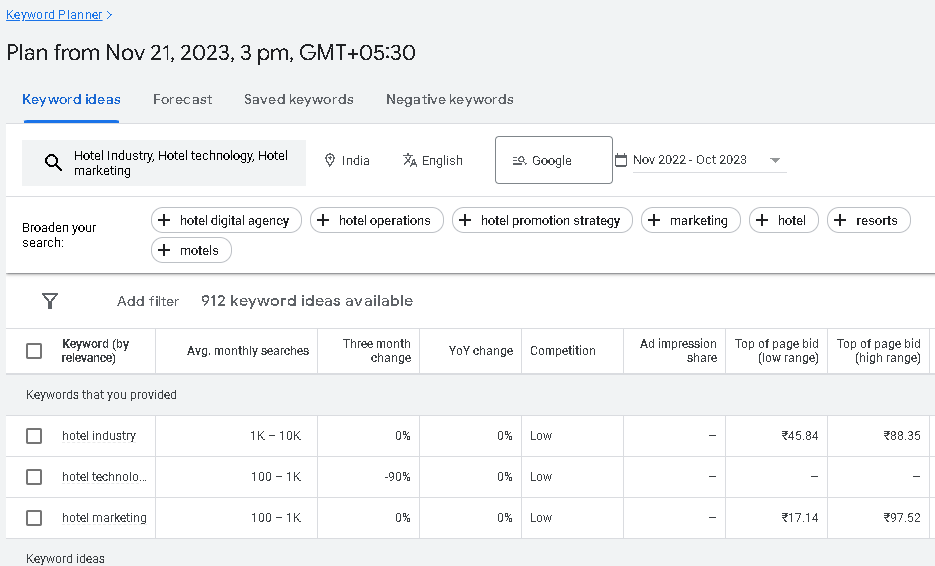
Ubersuggest
Step 1: Go to Ubersuggest
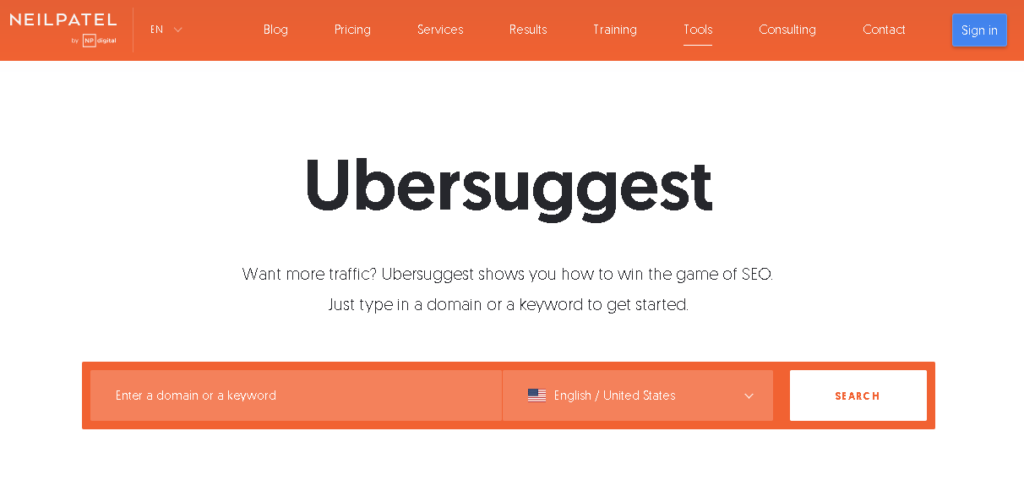
Step 2: Enter a keyword or an URL
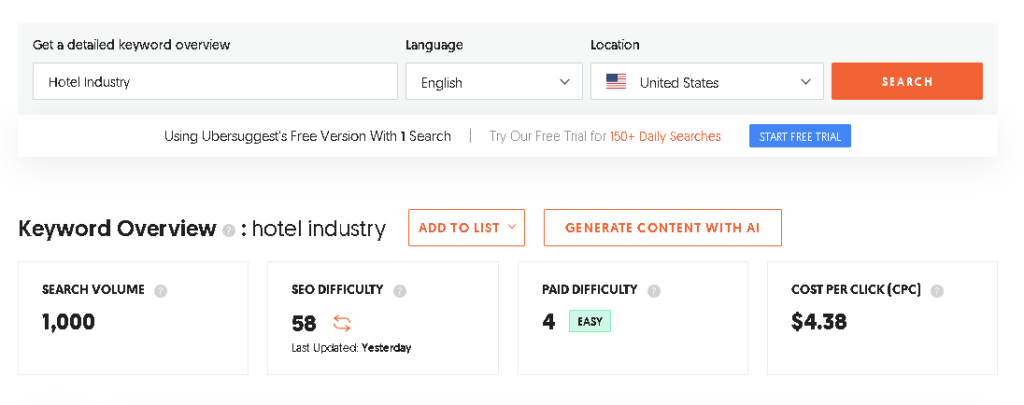
Step 3: Pick all the other relevant keywords
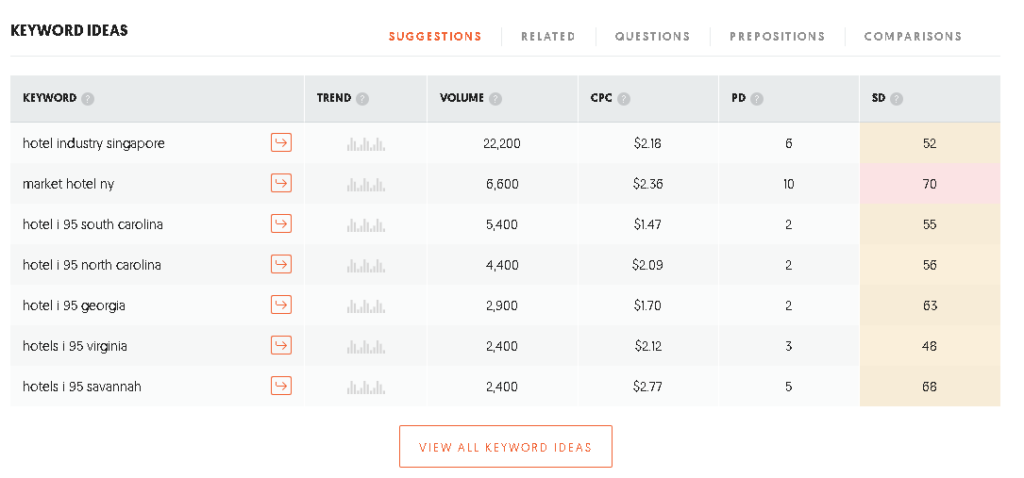
Further, decide on a focus keyword that resonates with your restaurant. And then add other keywords in the content as per the relevance.
Word To The Wise: When you pick the keywords, go for the ones with higher search volume and low competition.
#ProTip: Do not stick to only one form of keywords (i.e., short form). Explore and try to incorporate long-tail keywords as they are more likely to convert the audience.
#4 Work on the meta title, meta description, and URL
Here are the next things that need your focus.
- Meta title: It is the title of a page that is displayed in search engine results and the page’s tab in browsers.
While writing the page title, you have to ensure that your focus keyword is included in it. Also, it is a good practice to keep the character limit to 60.
- Meta description: Just like the meta title, the meta description also appears in the search engine results. It describes or summarizes the contents of a page for the benefit of users and search engines.
Furthermore, a focus keyword is necessary here too. And just like the meta title, try to write the description keeping the limit of 160 characters in mind.
- URL: Also known as a “web address”, the URL specifies the location of a web page on the internet. In terms of SEO, it helps search engines understand what the content is all about.
Note: There’s a character limit involved in the meta; however, you can still keep a longer title. But Google will truncate that in the search results.
So, you must keep it clean and easy to understand. Also, do not stuff it with the keyword if it’s not fitting in naturally.
Meta titles, meta descriptions, and URLs play a crucial role in SEO. They serve the function of advertising copy draw readers to a website from the results page and improve the click-through rate.
#5 Optimize content on the website
Content optimization is another effective SEO strategy for restaurants. Whether it’s a new website or an existing one, it is really important to optimize each and every piece of content on your website.
Try to serve quality content to enhance the audience experience on your website.
Furthermore, it’s not just the content on the homepage or any other page of your website. You can further extend your SEO game by writing blogs.
For example: You can curate blogs for people who are on the lookout for places that serve Middle Eastern cuisine with a title such as “10 Best Places to Try Shawarma in Bangalore”
You can include numerous keywords in a blog to make it SEO-friendly and drive better traffic.
#6 Improve your website load time
Page loading speed is one of the major factors in Google’s ranking algorithm.
Furthermore, when a page takes more time to load, the bounce rate increases and the average time on the page gets lower.
So, ensure you are performing all the necessary actions on your website to make it load fast.
Here are some things you can consider:
- Reduce the size of your CSS, HTML, and JavaScript files
- Eliminate code comments, formatting, and unused code
- Remove render-blocking JavaScript
- Make use of browser caching to avoid slow loading for repeat website visitors
- Improve your server response time
- Optimize images to load faster
You can check your website loading speed here.
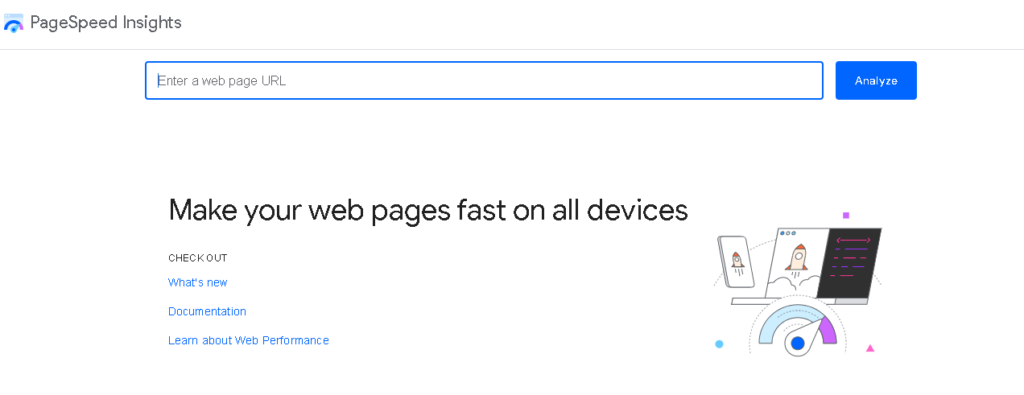

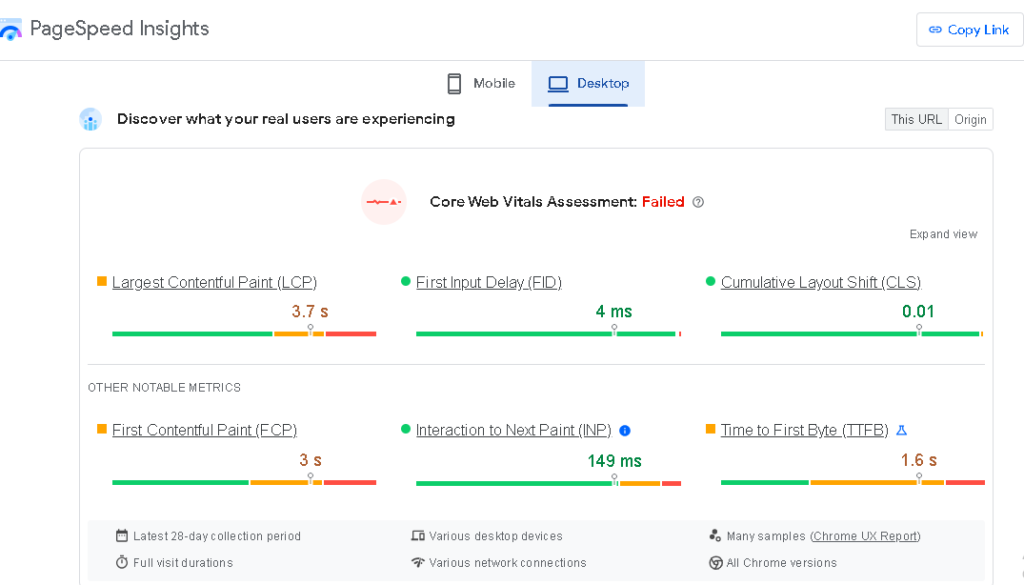
#7 Make your website mobile-friendly
Last year, Google announced its mobile-first indexing for the whole web.
Meaning? Websites that are mobile-optimized are more likely to rank on Google search results.
Therefore, it is more important than ever that website owners do everything needed to make their sites work on mobile devices flawlessly.
Here are certain things you can consider:
- Start by determining whether your site passes Google’s mobile-friendly test (if it does, then well and good.)
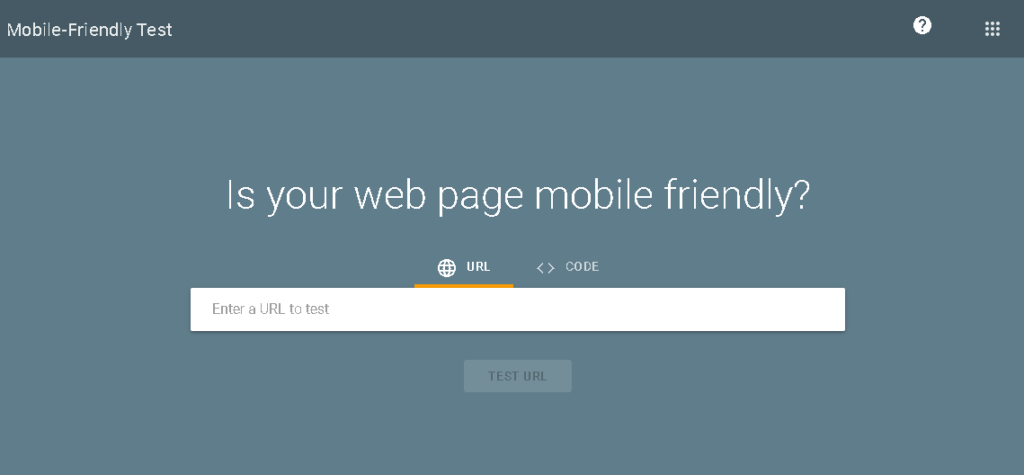

Note: You can also search for ‘Google Mobile-Friendly Test’ and it will come up in the search results.
- If it fails, work on the design, the content, the server, and every other aspect that affects your website’s performance on mobile devices.
- Make sure to abide by Google’s criteria such as readable text, and avoiding software not common on mobile devices.
- Further, avoid putting up unplayable content, and repair irrelevant cross-links.
#8 Work on image SEO
Downloading a stock image and then uploading it on the website is easy. However, when you’re doing SEO for your restaurant’s website, you have to know about image SEO as well.
Here’s how you can do SEO for images:
- Choose the right image format (the recommended formats are JPEG & PNG)
- Compress the images and also adjust the aspect ratio before uploading them to the site
- Make sure there are no copyright issues on the image
- Create descriptive, keyword-rich file names
- Write SEO-friendly alt text as it is used to describe the content of an image file
#9 Use Google search console
Google search console is one of the most important things to consider when you have a website. This tool by Google lets you monitor your website and helps resolve server errors, site load issues, and security issues.
You must use this tool if you want to achieve better SEO results.
Further, there are two things I would like to cover while I am talking about Google Search Console.
- Sitemap: It is basically a blueprint of your website. Using the sitemap.xml file, search engines like Google get to know what website content it needs to find, crawl and index.
- Core Web Vitals: These are reports that help you learn and understand how your website pages perform. And it is based on real-world usage data.
Also, if you want to know how to set up Google Search Console, here’s a blog by Aja Frost, HubSpot.
The Ultimate Guide to Google Search Console
Off-Page SEO
In off-page restaurant SEO, the actions are quite different. Following are the things you have to consider:
#1 Get listed on other platforms
Food delivery apps already have a great reach. So, when you partner with them or get listed on them, you can increase your chances of getting seen.
Also, with time, when you build a reputation, you’re more likely to land online orders.
Not to mention, many people tend to visit a restaurant after checking them out on these food delivery apps.
#2 Improve your local SEO
Apart from working on the restaurant website SEO, you also have to invest a good amount of time and effort in local SEO.
Local SEO is about getting seen on SERPs (which stands for Search engine results) in a specific location.
If you haven’t worked on your local SEO yet, then it is highly recommended to do so.
Here are some ways to improve local SEO for restaurants:
- Get listed on Google My Business
- Try and gather as many online reviews as possible
- Curate content (such as social media posts) around local happenings
- You can also try using proximity marketing
- Bet on voice search
While you should definitely work on all the points mentioned, try to emphasize on ‘Google My Business’ more.
We also have a dedicated blog on GMB for hotels. You can read it and steal some ideas.
Optimize Your Google My Business Listing
Word To The Wise: When you get listed on Google My Business or any other platform, make sure you maintain consistency in NAP (Name, Address, Phone Number). When you have the same details on every platform, it is easier for people to get in touch with you.
#3 Have a strong social media presence
Social media plays a vital role when it comes to marketing your business. And it is really important to bet on it.
According to a report, more than 3.6 billion people are using social media worldwide, and the numbers are prophesied to grow to almost 4.41 billion in 2025.
So, you can understand how much of an impact social media has.
Therefore, ensure that you have a strong presence on the relevant platforms. From posting photos of your restaurant to posting updates, you have to make sure you’re connecting with your audience.
Not to mention, social media also drives a significant amount of traffic to your website.
Social Media Strategies For Restaurants
#4 Try guest blogging
If you don’t know what guest blogging is, it is an SEO strategy where you can write and publish a blog post on a third-party website to promote your products/services.
Guest blogging is an underrated restaurant SEO strategy when it comes to content marketing. But if done right, it can be of great benefit.
If you would like to have a dedicated blog on guest blogging, do let me know in the comments.
#5 Work on building links
Building links is basically about acquiring hyperlinks from other websites to yours.
For example: If some blog or website has written and published about ‘Top 10 cafes in Mumbai’ and they have listed your establishment with a link to your website, then it’s a form of link building.
It is one of the most effective ways of SEO because search engines like Google crawl links between individual pages and then crawl links between websites.
If you want to understand link building better, Paddy Moogan from MOZ has written a fabulous blog.
The Beginner's Guide to Link Building
FAQs
Any type of restaurant can do SEO. They just need to have the prerequisites such as a website.
If you have domain knowledge, you can definitely get your hands on it. Basic SEO doesn’t require in-depth knowledge. However, it is advised to consult a professional.
You can use tools like Google Keyword Planner and Ubersuggest to look for keywords related to or from your industry.
Google Ads are paid online advertisements and it does not interfere with your SEO activities.
Despite their difference, both ads and SEO have their own set of benefits and do equally well.
Conclusion
SEO is a vast domain. There are several things to look into when you go about doing SEO in-depth.
In this blog, I have tried my best to keep things as simple as possible and provide you with a practical SEO plan for your restaurant. As you’re a restaurateur and not a professional, this blog on SEO tips for restaurants will help you with all ground-zero tips.
You can implement them in your restaurant SEO strategy and see them yourself.
Further, there’s one thing I would like to add before I wrap this blog.
When implementing the above-mentioned restaurant SEO tips, do not sit idle and wait for the results. Keep checking the performance of your SEO efforts for your restaurant website. Tools like Google Analytics and Google Search Console will help you understand every aspect clearly.
Do let me know if you have anything else in mind regarding this topic or if I have missed out. I will definitely add them.


